

It is now obvious to anyone other than a modern-day Rip van Winkle who has recently awakened that we have entered into the age of networked computing. Yes, computers everywhere, from the home to the office, are all becoming interconnected via the Internet, and "information at your fingertips" has finally become a reality thanks to CERN physics researcher Tim Berners-Lee and Mosaic creator and Netscape Communications Corp. Senior Vice President of Technology Marc Andreessen. It's a wonderful age! We can swap e-mail, and we can find out about things we don't know in seconds. Everything is great expect for one problem--none of this was planned.
That's right, no central authority--no government, no telecommunications monopoly, no giant computer corporation--decided that all the people of the world should be interconnected via the Internet. In fact, the basic technologies underlying the Internet were actually created to put "U.S. government sponsored researchers and their computers," not Mr. or Ms. average citizen and his/her PC, on line. Moreover, these underlying technologies were designed to survive the chaos of a nuclear holocaust, so not only is there no centralized human control to regulate illegal activities, such as the dissemination of child pornography, but there is also no centralized machine control either. This may not seem like a big deal to people who can't consume enough of what the Internet has to offer, but when we compare the Internet to the telephone system or a paper library, a lot of problems begin to emerge.
First, there is the problem of reliability. Has your Internet service provider's server every gone down unexpectedly? Is it shut down regularly for maintenance causing you to lose access to the Internet? Have you ever sent an e-mail message that was never received by the person to whom you sent it? Has a person to whom you sent an e-mail message ever written back saying the header was received but there was no message attached to it? In the case of most people, the answer to these questions is "yes." But in comparison, loss of telephone service is now an extremely rare occurrence that happens mainly due to natural disasters. When it's a result of an error by the telephone company, all hell breaks loose and large-scale rebates have to be paid out to placate angry customers.
Second, there is the problem of security. Are you willing to provide your credit card number to anyone via the Internet? There are lots of services on the Internet that have little forms just waiting for you to fill them in with your credit card number, but is it safe? You've heard that hackers have repeatedly cracked security devices built into web communications software, so what are you to believe? On the other hand, most people today would have no qualms about giving their credit card number to a business representative via the telephone. What's the difference? In the case of the telephone system, a "virtual dedicated connection" is temporarily created between the customer and the business representative via centralized switching systems. This is impossible with the Internet, since there are no central servers. As a result, messages are broken down into packets and sent every which way.
Third, there is the problem of responsiveness. For example, although software has appeared that allows Internet subscribers to make "telephone calls" to another person with the same software and an Internet connection, the result is more like a "citizen's band radio" interchange rather than a telephone call as we know it. In other words, there is a lag between transmission and reception of voice signals when two people use this software. In addition, there can be a problem even in the transmission and reception of lowly electronic mail. Sometimes if two messages are sent to the same address within a few minutes of each other, the latter can arrive before the former as a result of their being routed via different servers. Accordingly, real-time communication is something that is extremely difficult to realize on the Internet.
Fourth, there is problem of locating the specific information that you seek among the masses of information that have been put on line to date. One might think that the various Internet "search engines" can cover this problem, but as most people have found out when they perform a "key word search," search engines spit out as many unrelated links as related ones, and they spit them out by the tens of thousands. The basic problem, of course, is that the Internet lacks good centralized directories and subdirectories of available information through which to route search requests. Accordingly, the result of many information searches for data on the World Wide Web ends up as "inforrhea at your fingertips" rather than "information at your fingertips."
So what does this all mean? Well, for starters it means that the Internet--convenient as it may be--is merely one type of network technology, which like any other technology has its pluses and minuses. Specifically, it's a wide area network of sometimes dubious reliability that lacks both safeguards for securing private information and real-time responsiveness. In addition, the Internet lacks mechanisms that allow for data to be searched for in a systematic and controlled manner. This shortcoming will grow more and more serious as more and more data are put on line, because every failed data search is ultimately a waste of transmission capacity. On top of that, new Internet applications requiring high bandwidth, such as digital telephony, video conferencing, live audio broadcasting, and video on demand are either coming on line or being planned, which makes it likely that the transmission capacity of the Internet will continually be pushed to its limits and beyond.
Of course, there are very understandable reasons why the Internet has its loyal supporters. Most importantly, the fact that governments don't control the Internet means it can give a voice to people or groups of people certain governments would like to suppress. So in that sense, it is of immense cultural importance. Another important feature of the Internet is that it is still "open technologically," so anyone can become a player without paying royalties or worrying about a lawyer from a large software company walking through the door with a ultimatum to either sign a highly unfavorable contract or have access to the Internet denied. However, in the final analysis, even the hard core fans of the Internet have to admit that when it comes to underlying technologies, the Internet is lacking in many areas.
Fortunately, there are other global network development efforts under way in addition to the Internet. One of these is the TRON Hypernetwork (in technical parlance, the highly functional distributed system [HFDS]), a vast, high-performance, real-time hypernetwork of innumerable open and closed subordinate networks based on the TRON total architecture that is being planned for computerizing human living spaces and human work environments in the 21st century. This hypernetwork is in the process of being built around a central framework of real-time servers and digital exchanges based on the Central and Communication TRON (CTRON) architecture, one of the first tasks of which is to support today's Internet protocols.
The CTRON architecture is being designed to handle centralized multiuser data server and switching/communications tasks within the TRON Hypernetwork. Although it is a "real-time, multitasking" architecture like the other TRON subarchitectures, it is very different from the others in that CTRON-based systems have to demonstrate an average response time on the order of a few hundred milliseconds while processing "tens of thousands" of tasks simultaneously. Moreover, systems based this subarchitecture have to realize such operation in many cases while being "fault-tolerant," which is to say operation of the CTRON-specification system must continue uninterrupted even though something goes wrong. Finally, since it is very expensive and time consuming to develop software for individual portions of a telecommunications or data server networks, the CTRON specifications had to take "software portability" into account, which is to say CTRON has to make it possible to move software from one manufacturer's equipment to another.
In order to increase processing speed, the CTRON architecture, like the ITRON architecture, was not originally intended for use with a human-machine interface--that's mainly the role of the BTRON-specification computer in the TRON Hypernetwork. However, there the similarities between the two end, in spite of the fact that CTRON was initially designed on the basis of ITRON. Unlike ITRON, which uses a "priority-based multitasking" scheme, CTRON uses "round-robin multitasking" in which all tasks are treated equally. CTRON, unlike ITRON, in addition has to support multiple users, perform scheduling for time sharing, carry out access authentication to see who's allowed to enter a system, and allocate and release system resources as users come on and off line. In short, it's much more sophisticated than ITRON, and consequently it's considerably larger.
The CTRON architecture is divided into a dual-layer operating system hierarchy: a hardware-dependent basic operating system layer at the bottom, where the kernel and input/output control are located; and a hardware-independent extended operating system on top of it, where data storage, communication control, speech path control, execution control and operation, administration and maintenance management functions are located. This dual-layer operating system model (Fig. 1), which is referred to as a "virtual machine" approach in technical parlance, allows CTRON-specification operating systems to operate on any computer's CPU, and it makes it possible for the extended operating system functions, in addition to the software applications, to be ported from one manufacturer's system to another. Interestingly, although this virtual machine approach creates a "level playing field" par excellence in which all manufacturers can compete with each other on an equal footing, the Office of the United States Trade Representative actually listed CTRON as a potential trade barrier in its annual report in 1989! Fortunately, no action was ever taken on this highly mistaken claim.
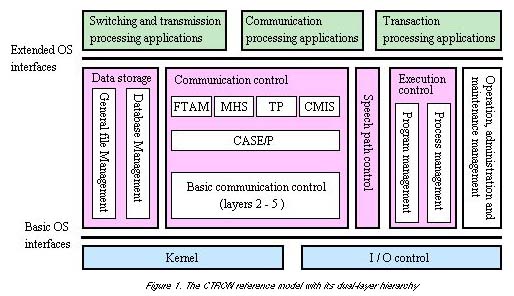
Another interesting feature of the CTRON architecture is that it is divided into a number of subsets. This is because it is intended for use on both small-scale and large-scale network hardware. First, there is a microsubset of 48 system calls that is for use on small-scale network equipment, such as gateways and protocol converters, which are connected to large-scale CTRON-based systems. Second, there is the common interface unit of 88 system calls, which includes the microsubset system calls, for large-scale equipment, i.e., mainframe computers and digital exchanges. Third, there are two sets of enhancements for the common interface unit, which are a high-level optional interface unit of 19 system calls and a virtual memory optional interface unit of 22 system calls. As a result of the virtual machine approach and the division into subsets, it is possible to set up a highly flexible system of front- and back-end processors that can be programmed as a single machine.
It should be pointed out that the Original CTRON Specification Series, which is available in both Japanese and English versions, now totals 12 volumes and runs into the thousands of pages. It should also be noted that these standards do not conflict with other standards developed elsewhere in the world. In other words, where a standard exists, the CTRON specification generally follows it, and where no standard exists, the CTRON specification creates one, keeping in mind the real-time processing goals of the TRON Project. The CTRON specification also boasts some novel features, such as program/network and program/device interfaces, in addition to mechanisms for managing indexed files. Moreover, since there is constant feedback from companies implementing CTRON-specifications to the CTRON Technical Committee, the stage has been set to develop this architecture fully to meet the needs of the information societies of tomorrow.
The CTRON subproject of the TRON Project actually grew out of the merger of an independent common OS interface specification study project, which was launched by Nippon Telegraph and Telephone Corp. (NTT) in conjunction with NEC Corp., Hitachi Ltd., Fujitsu Ltd., Mitsubishi Electric Corp., Toshiba Corp., and Oki Electric Industry Co., in February 1986, and the CTRON study efforts that were in progress inside the TRON Project. The two were officially merged in June 1986. And then in August 1987 the CTRON Technical Committee was officially established within the TRON Association (Fig 2.).
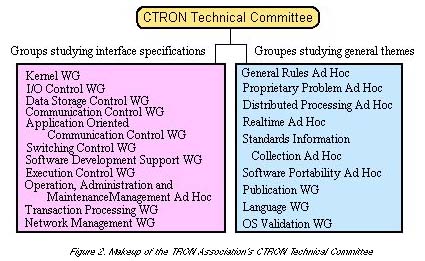
Unlike the other TRON subprojects, the major milestones in the CTRON subproject have more to do with drawing up and testing of software specifications, rather than the actual development and commercialization of new CTRON-specification products. This is not to say that new CTRON-specification products have not been developed from scratch, because many have been. However, it is no exaggeration to say that the drawing up of the CTRON specification itself, which is a massive effort involving hundreds of engineers on loan from TRON Association member companies, and the validating of products based on the CTRON specification have overshadowed the development and commercialization of new CTRON-specification products.
The Japanese-language edition of the CTRON specification was made public starting in November 1987 with the volumes dealing with the interface specification and the kernel and I/O control interfaces (i.e., the hardware-dependent portions of the CTRON reference model). The first three English-language volumes with the same contents appeared in the summer of 1989. In spite of the fact that the CTRON specification is a virtual "operating system specification encyclopedia," it was found lacking in certain "semantic details" when a team at Tandem Computers--the world's largest manufacturer of on-line transaction processors--began developing a fault-tolerant implementation of the CTRON basic operating system for the company's Integrity series servers. The missing details were eventually implemented through contacts with NTT, which is both the main force in the development of the CTRON specification and a major purchaser of CTRON-specification systems in Japan.
In addition to the publishing of the CTRON specification in both Japanese and English, other milestones in the development of the CTRON architecture are:
Validation of CTRON-specification products (Fig. 3) is performed to ensure that developers have properly implemented and documented the CTRON specifications concerned so that variants and/or incompatible CTRON-specification systems do not come into existence. In addition to guaranteeing interoperability among different CTRON-specification systems produced by different manufacturers, validation also improves the portability of software across CTRON-specification systems. To date, 16 implementations of the basic OS and 5 extended operating system products have been certified as conforming to CTRON standards, thus earning them the right to display the CTRON logo. The validation tests cover both product documentation and the operating system software. In the latter, a special validation suite is used.
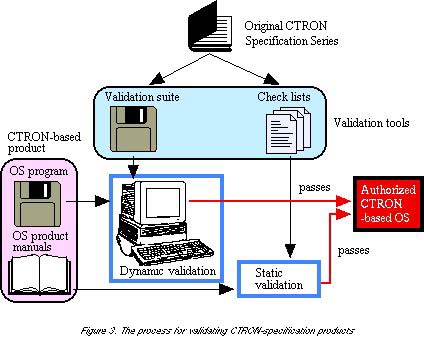
One of the main goals of the CTRON subproject is to make it possible to port the CTRON extended operating system functions and application programs from one maker's platform to another. The reason for this is that both the operating system functions and the application programs for large centralized computer systems are huge, and hence rewriting for each maker's platform would require a considerable engineering effort at great expense over a long period of time. Accordingly, in order to test portability, the CTRON Technical Committee in conjunction with the University of Tokyo conducted a series of 19 porting experiments over a three-year period, which ended in May 1992. In the experiments, nine different CTRON interface units were ported among different systems. As a result of these experiments, CTRON researchers learned it was possible to port 98 percent of 600 KL of source code without modification. In addition, the results of these experiments shed light on where there were problems in attempting to port software across systems, and they also showed that porting can achieve the same results as completely new development with only 15 percent of the effort in terms of man hours.
The TRON Architecture is all about real-time multitask processing in networks, and the CTRON subarchitecture is the linchpin of those networks. Thus it is important that CTRON-specification systems demonstrate outstanding real-time performance while achieving high rates of multitasking. However, at present there are no objective criteria for evaluating real-time performance. Accordingly, a study was launched to establish a series of benchmarks, such as task interrupt response time, etc., to evaluate real-time performance of CTRON-specification operating systems. These benchmarks showed that CTRON-specification operating systems are able to achieve a fixed response time even as the number of tasks to process increases. They also showed that CTRON-specification operating systems are superior to real-time UNIX (Fig. 4), being from two to 10 times as fast depending on the evaluation criterion. In addition to the real-time performance of the basic operating system, criteria were drawn up for evaluating total system performance in the various application areas by establishing models for such application fields as switching processing and communications processing.
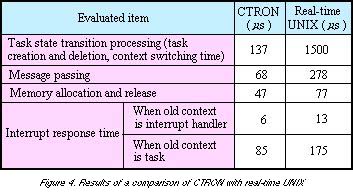
All the issues surrounding the preparation, validation, performance evaluation, etc., of the massive CTRON specification are highly interesting from the viewpoint of systems engineering and digital infrastructure creation. As a matter of fact, it's the type of thing one could write a very interesting book about, given the size and goals of the CTRON subproject in particular and the TRON Project in general. But some readers are more pragmatic and are probably wondering exactly what kinds of CTRON-specification products have been developed and commercialized to date. So let's take a little time to outline some of the commercializations that are based on the CTRON specification.
Given the size and resources of the companies involved in the development of the CTRON specification, it should come as no surprise that several large server-class computer systems have been developed on the basis of the CTRON specification. As mentioned above, Tandem Computers has developed a CTRON-specification basic operating system for its Integrity series of non-stop servers. The latest model, the C1475, uses CPUs based the 64-bit R4400SC MIPS chip with a clock of 75MHz. Fujitsu has also developed a CTRON-based non-stop server in this class, the Sure System 2000, which uses CPUs based on the Gmicro 300, a microprocessor based on the TRON VLSI CPU architecture. Another fault-tolerant CTRON-specification processor series is the OKITRON-L/M series, which uses CPUs based on the Motorola MC68040 running at 25MHz.
In addition to the server-class machine, Oki Electric also manufactures a private branch exchange (PBX) series, the iOX100 series consisting of the iOX110, iOX120, iOX130, and iOX140, which are all based on the micro-CTRON operating system specification. A CTRON-specification PBX series has also been developed and commercialized by Mitsubishi Electric, which is marketed as the MELSTAR ES2000 series. Both of these PBX series can provide Integrated Services Digital Network (ISDN) services based on internationally recognized CCITT (International Telegraph and Telephone Consultative Committee) standards. Mitsubishi Electric has also developed a CTRON-specification high-speed packet switching system called MELPAX5000 and a CTRON-specification wide area monitoring and control system called MELFLEX440.
It should be pointed out here that CTRON-specification microkernels run on all the major microprocessor families, both CISC-based families from Intel Corp. and Motorola Corp. and RISC-based families such as Sun Microsystems Inc.'s SPARC family and Silicon Graphics Inc.'s MIPS family, in addition to microprocessors based on the TRON VLSI CPU architecture. CTRON-specification microkernels have also been burnt into ROM and incorporated into ISDN terminals. Thus CTRON-specification systems cover the full range of application fields in networks, from the huge centralized systems that form their backbones to the small terminals that serve as their nodes.
As for application development, UNIX users might find it interesting that NTT has developed an emulator of the CTRON basic operating system called BOSEM (Basic Operating System EMulator), which emulates the CTRON basic operating system in the familiar UNIX workstation environment. This makes it possible for UNIX pros to efficiently develop and debug CTRON-specification extended operating system functions and application software on their UNIX engineering workstations.
When the TRON Project was officially launched in 1984, four basic technology development subprojects were begun to create the core technologies that would underlie the TRON Hypernetwork. These are: ITRON for embedded use and machine control; BTRON for use in single-user multitask personal computers and workstations; CTRON for providing centralized data and communications services in multiuser networks of varying size; and TRON VLSI CPU to serve as the core of the hardware platforms that would support the other three application fields.
To date, two of the basic technology development projects, ITRON and CTRON, have been smashing successes. This is to say, they have come into widespread use and have firmly established themselves as "standards" in Japan, and they are now on their way to making inroads into overseas markets. Of the other two, one, BTRON--to the incredulity of many observers who predict trends in the Japanese personal computer market--is making slow but continuous progress toward eventual acceptance as a viable standard for use in personal computers and workstations, and particularly as a high-performance operating system for PDAs. And finally one, TRON VLSI CPU, has proven unpopular and is unlikely to attract further development resources.
Some critics of the TRON Project would say that the only reason the CTRON subproject has succeeded is because a large Japanese telecommunications firm, NTT, along with its suppliers have backed the project. It is true, of course, that either a powerful backer or a very large number of backers is needed to create a new standard. But it is important to stress the fact that CTRON has succeeded as a standard in Japan not only because it has powerful backers, but also because it has attained its design goals and as a result offers the performance that the customer wants. In fact, as noted above, CTRON's outstanding real-time performance together with its flexibility and functionality put it in a class by itself.
Okay, okay, CTRON's now a standard in Japan. So where's it headed?
When the CTRON subarchitecture was in the planning stages in the 1980s, the main topics of interest for telecommunications providers were how to provide ISDN services and the International Standards Organization (ISO) interface protocols called Open Systems Interconnection (OSI), which were intended to allow communication between different makes of computers. ISDN would allow for simultaneous voice and data transmission, G4 facsimile transmission, etc., while OSI would enable CTRON-specification computers to link up with any other computers in the world. In other words, the goal for the CTRON architecture was to do what was being done on analog circuits, only do it faster and better on digital circuits.
Note: for those interested in the history of digital telecommunications technology, it might be worth pointing out that digital communications technology developers in the 1980s were predicting we would be able to connect our PCs directly to telephone circuits without the need for a "modem." So what do we have today? So-called ISDN modems!
However, in the last several years the Internet has appeared on the scene and has proved explosively popular throughout the world. This took a lot of people by surprise. It took the inventors and early users of the Internet by surprise; it took Bill Gates who spent a lot of time talking about "information at your fingertips" by surprise; and it took many people at telecommunications companies by surprise, including those people working on the development of the CTRON architecture and CTRON-specification applications. In particular, telecommunications companies are amazed at the breadth of the multimedia applications that have come into use on the Internet, and they are awed by the amount of bandwidth and centralized processing power that has to be provided to enable subscribers to use these new applications.
As a result of this trend toward rich multimedia content in Internet documents and Internet broadcast services that stream out video, voice, and music data, studies are now in progress about how to expand and optimize the CTRON architecture to implement these services that today's general-purpose operating systems just cannot cope with. In particular, the following topics are currently being studied by CTRON researchers.
Besides improving and expanding support for today's Internet protocols, the CTRON Technical Committee also aims at assisting in the creation of tomorrow's new international standards for communications and multimedia processing by cooperating with international standards bodies. Accordingly, CTRON researchers have carried out presentations on the CTRON architecture in 1990 and 1991 at the Telecommunication Information Networking Architecture (TINA) Consortium, which was established to study a platform for real-time distributed processing. Moreover, they are actively participating in the Digital Audio Visual Council (DAVIC), which aims at creating specifications for open interfaces and protocols that will allow interoperability of digital audio-visual applications and services across international borders, and the ATM [Asynchronous Transfer Mode] Forum, which draws up specifications to ensure the worldwide interoperability of telecommunications network equipment and services based on ATM technology.
In order to promote the use of the CTRON architecture and spread its advantages to the far corners of the world, the TRON Association held a micro-CTRON kernel programming contest. Applicants worldwide were asked to create a microkernel that implemented the 48 systems calls of the micro-C subset of the CTRON Kernel Specifications that included a C language (ANSI/ISO) binding interface as defined in CTRON specifications. There were no restrictions on the target hardware platform for the micro-C kernel and no restrictions on its run-time environment (i.e., processor type, memory size, cache size, etc.), but applicants were asked submit documentation explaining their implementations. An international group of scholars and members of the CTRON Technical Committee selected winners on the basis of conformance to the CTRON specification, universality of running environment, degree of portability, and performance. The winning entries are being made available as free software via the Internet.
The successes of the TRON Project are not usually reported in the western news media, and the project is normally written off as a failure by western "experts" who have only a superficial knowledge of what the TRON Architecture is and how far it has been developed. However, the TRON Project is carefully watched in other countries, particularly Asian countries, where the "it wasn't invented here" mentality does not exist. One of the countries in this category is China, where a series of technical seminars on TRON technologies was held in the cities of Beijing and Shanghai. The response to these seminars was highly enthusiastic, and, as a result, China's largest software house, China National Computer Software & Technology Service Corporation (CS&S), sent a delegation to Japan in September 1996, and subsequently signed a letter of intent to cooperate in the development of CTRON-specification systems for China's telecommunications networks. Thus the possibility is great that the CTRON architecture is going to spread and become something approaching a regional standard in East Asia in the future.
Basic information on the CTRON architecture can be obtained from the proceedings of the annual TRON Project symposia. These were published by Springer-Verlag from 1987 to 1990, and have been published by the IEEE Computer Society Press since 1991.
The CTRON specification, which outlines the CTRON architecture, was expanded into 12 volumes and published in November 1992 as the New Edition of the Original CTRON Specification Series by Ohmsha Ltd.
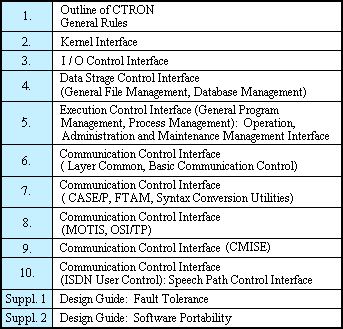
Ohmsha Ltd.'s address and contact information are as follows:
3-1, Nishikicho, Kanda, Chiyoda-ku, Tokyo 101 Japan
Tel.: 03-3233-0641 (after hours: 0681); Fax.: 03-3293-2824
The best source for further technical information on the CTRON subproject is the CTRON home page of the TRON Project web site at the University of Tokyo. The URL is as follows:
http://tron.um.u-tokyo.ac.jp/TRON/CTRON/intro-e.html
Free source code for the award winning entries of the micro-C programming contest can be downloaded from the following site.
http://tron.um.u-tokyo.ac.jp/TRON/CTRON/home.html
